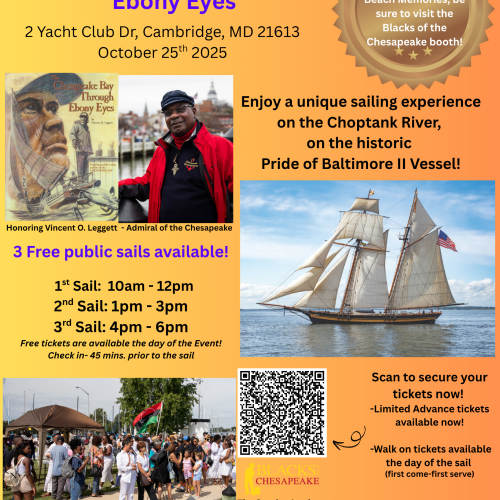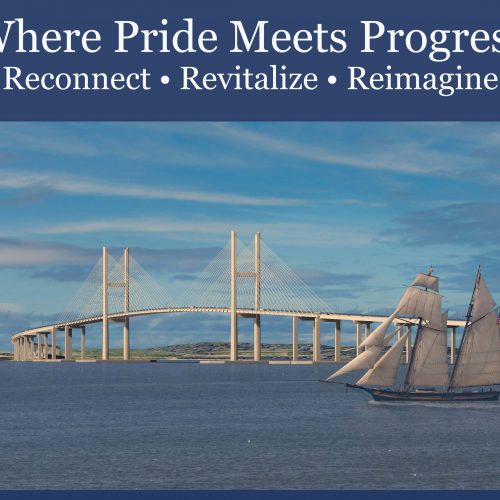Photo: Pride II Sailing under the Chesapeake Bay Bridge. Photo courtesy of Susan Hale
Date: Wednesday, May 13, 2020
Time: 1900 hours
Location: Anchored on the eastern side of the Chesapeake Bay, south of Rock Hall near the western shore of Eastern Neck
There was no wind this morning, as forecast. So the morning was spent attending to vessel details. Inspecting the rig. Also some cleaning.
Somewhat unexpectedly an east-southeast breeze arrived late morning. Pretty fresh too. Meaning 10 knots and a bit better. The updated forecast continued indicating 5 knots from the south. After a moment of thought, it was easy to realize this new breeze was a result of temperature differences of air over land verses air over water of the Chesapeake Bay.
Whenever there is a broad area of uniform and stable air mass over both water and land, and the sky is clear, the sun starts to heat the surface of water and land early in the day. Water does not heat up as quickly as land does. Today it seems the land temperature had increased pretty quickly while the bay water did not as quickly. As the land heated this morning, the air close to the ground heated as well and started to rise. Over the bay the cooler near-surface air was drawn towards the land by the rising warmer air over land. This flow creates localized breezes near shorelines. The greater the difference of temperature the faster this flow near shorelines. So, by midday in Annapolis, we were seeing 10-12 knots of wind flowing right up the Severn River. A good sailing breeze. But one that would require tacking back out Severn River Roads. Because the wind was not as speedy as it was yesterday, it would be less work for the crew to tack Pride out towards the bay. But still, it would mean short tacking hence plenty enough work.
Today’s sail from anchor would best be served to have the mainsail set prior to hauling back the anchor. Close astern by about 300 yards was the seawall of the Naval Academy. It would be important to pay off on a tack long enough that it would give the crew a chance to set additional sail to both aid in balancing the mainsail as well accelerate Pride after the anchor was off the bottom. Not merely accelerate but accelerate her enough over a short distance before needing to tack before running out of depth near either side of the Severn River.
Today the goal was to pay off on a port tack and sail to the southern side of the river, near Eastport Yacht Club. A distance of 450 yards from the anchored position. The mainsail boom was hauled to the starboard quarter to use the mainsail as an air-rudder for twisting the bow to the right. While hauling back the anchor, and carefully watching the swing of the ship, there were a few times the crew stopped hauling in the anchor to await a favorable swing. Finally, close to when the anchor would come off the bottom, there was a favorable swing. The anchor was lifted off the bottom and brought to the waterline, the jib was hoisted in a backed to port setup. The yards had already been braced backed to port. Pride twisted away to starboard, the mainsail filled, the backed jib kept twisting the Pride to the right. There is a lot of leverage with the jib so far forward of the mainsail, so Pride kept twisting against the filled mainsail to nearly beam to the wind. The jib was passed. The fore-staysail was set and both trimmed for going to windward. Pride started to accelerate and with steerage could be headed close to the wind. Then the loose-footed foresail was set. Being loose-footed the setting of the foresail is very fast. Merely let go of all brails at the same time and haul the clew aft-ward and close-in aboard with the line that is always attached. Then hook up the 4-part tackle to the foresail clew pendent and trim the 1,500 square feet sail. Then shift the yards around to starboard to reduce windage. Then tack as Pride approached the shore of the tip of Eastport.
It took seven tacks to finally get around Greenbury Point Shoal and head for the Chesapeake Bay Bridge. The square sail did not get set till after all of the tacking was completed. With the four lower sails, all being fore-and-aft, three of them loose-footed, there was plenty of work trimming after each tack with 14-15 knots of apparent wind. Pride was making 4+ knots on each leg. I decided to postpone setting the square-sail till after all the short-tacking. Were the wind less strong, the square would have been set so as to get additional acceleration. With plenty of acceleration, not setting the square was a favor to the crew not having to brace the square-topsail for each tack, forcing that sail through the wind. There had been plenty of that yesterday, in much stronger winds. A good photography show yesterday for sure. Making for a visually bold arrival to Annapolis for the first time this year. Without the foresail because of the stronger wind. With it there would have been too much sail area during yesterday’s gusts. Departing Annapolis did not call for a bold statement. The simplicity of fore-and-aft sails providing adequate acceleration for short tacking was plenty of visual proof of the ability for going to windward of the old-style Pride represents.
After the last tack, the square-topsail was set. Followed by the jib-topsail and the main-gaff-topsail.
Passed under and through the Chesapeake Bay Bridge and headed around Love Point, the northern end of Kent Island. Then close-hauled sailed east toward the anchorage. Turned downwind right close to shore to take all sail forward of the mainmast. Then rounded to port up toward the wind for dropping the port anchor around 1730 when Pride had lost way and started to drift astern. All sail and gear was stowed by 1830 and a delayed supper was had by all.
Signed,
Jan C. Miles, Senior Captain







